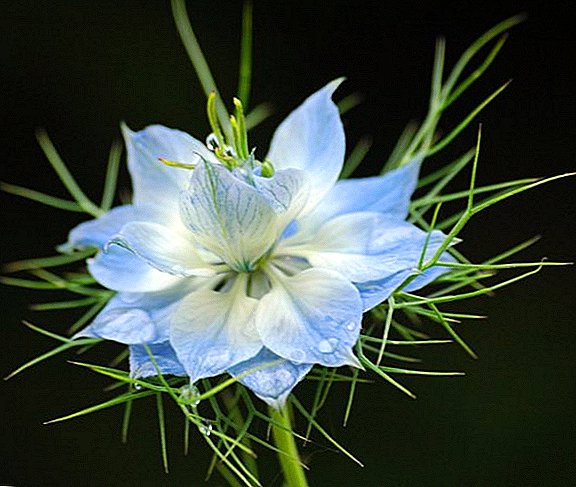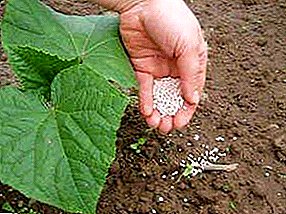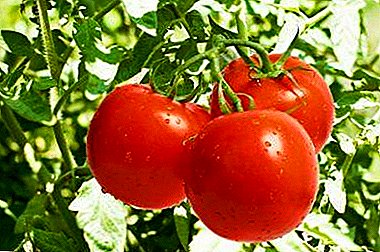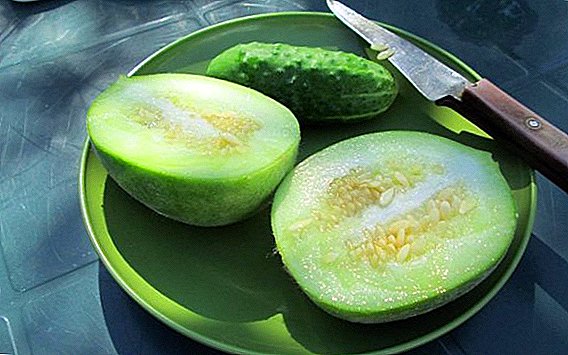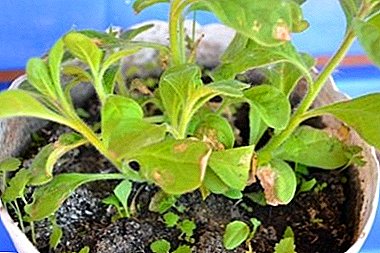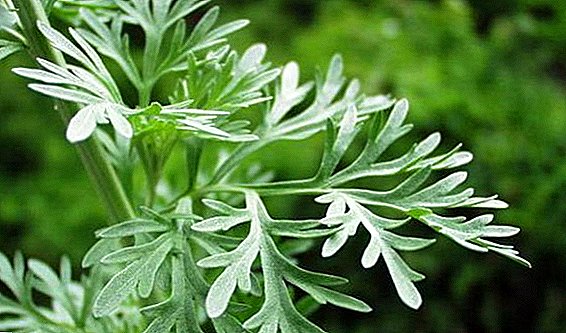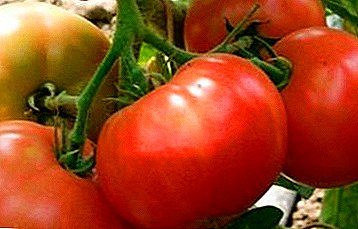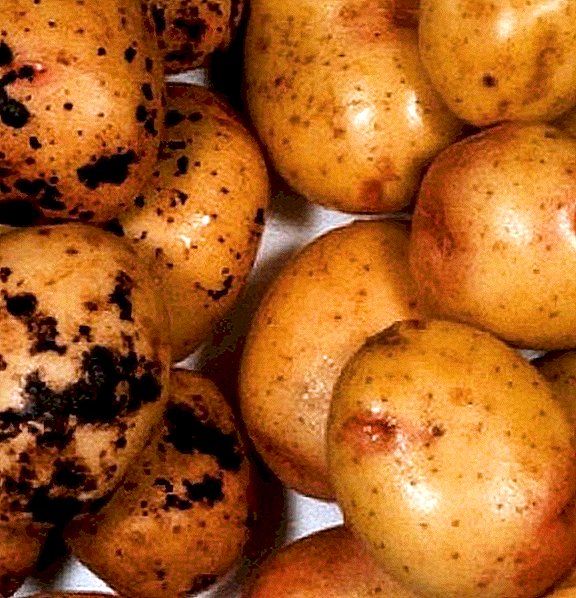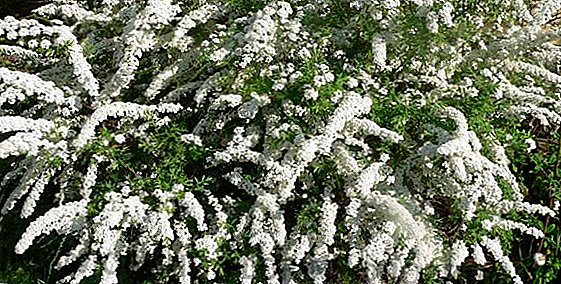 There is nothing more beautiful than having a flower garden near our house. Special beauty comes in the spring, when everything is blooming, and the flavors scatter hundreds of meters around. In this garden, the gray "Grefshaym" spirey, which is distinguished by multiple snow flowers on dense shoots, deserves special attention. In this article we will talk in detail about this hybrid spirea, let's look at the rules of planting and caring for a flower.
There is nothing more beautiful than having a flower garden near our house. Special beauty comes in the spring, when everything is blooming, and the flavors scatter hundreds of meters around. In this garden, the gray "Grefshaym" spirey, which is distinguished by multiple snow flowers on dense shoots, deserves special attention. In this article we will talk in detail about this hybrid spirea, let's look at the rules of planting and caring for a flower.
Botanical description
Variety "Grefsheym" was bred by breeders as a hybrid gray spirea. The main purpose of breeding was to bring a beautiful decorative look that would differ from its fellows in its pomp and resistance to certain diseases and pests. Spiraea bush "Grefshaym" can reach a height of 200 cm, while the diameter of the crown sometimes reaches 300 cm. The crown is spreading, the shoots are densely growing. The leaves are small, 2-4 cm long and up to 0.8 cm wide. Before the onset of the first autumn days, the leaves retain a greenish-gray color and have dense white pubescence from below. At the end of September, the leaves become a sunny yellow color. 
Did you know? Scientists have found that it is possible to synthesize glycoside salicin from Grefsham, a substance that, after a series of chemical processing, is converted to acetylsalicylic acid (aspirin).The flowering period of the bush begins in May. It is then that all the exquisite decorative qualities of Grefsheim are revealed. Its flowers are snow-white, small (about 1 cm in diameter). From the side it may seem that the spirea is covered with a layer of snow — small flowers are so thickly covered with shoots. The flowering period lasts 40-50 days. Starting from the second year, flowers become excellent honey plants and attract bees more and more.
The origin of the variety
Spiraea genus has about 100 species of bush plants. Most of them are easily interbreeding. This property of plants was used by breeders in 1949. They created a gray spiraea, while at the same time crossing the whitish-gray and beast-spreading spireas.
Familiarize yourself with the peculiarities of growing Japanese spirea, white spirea, Nippon spirea, Bumald spirea, willow spirea, Grefsham spirea, birch spirea, Wangutta spirea.
A new variety of ornamental bush has become more resistant to urban growing conditions, where there is an increased release of environmentally polluted vaporous waste. Since the beginning of the 50s of the last century, the hybrid has been enriched with many varieties. However, the most popular to date remains the grade "Grefsheym."
Use in landscape design
This beautiful bush is often used in decorative and landscape design to decorate the garden or flower beds as professional growers and beginners. Grefsheim can be used as a foreground accent, since it is simply impossible to ignore a beautiful white bush. It is possible to plant this variety of a flower by single landings or groups, combining "Grefsheym" with other representatives of the genus Spirea.  Landscaping classics used to grow "Grefsheym" around small ponds. The special attention of the spirea gray deserves among fans of the Scandinavian style and Provence, and all thanks to its simplicity, pomp and magnificent elegance.
Landscaping classics used to grow "Grefsheym" around small ponds. The special attention of the spirea gray deserves among fans of the Scandinavian style and Provence, and all thanks to its simplicity, pomp and magnificent elegance.
Important! The distance between the landing pits for Grefsheim should be at least 50 cm, since the roots of the bushes grow quite strongly.Spirey border will be a great decoration of the terrace or garden path. In addition, hedges allow you to select a specific area, for example, planting a lawn. "Grefsheym" appropriate to plant in rockeries, rock gardens or mixborder beds. You can always experiment, the main thing is not to mix styles and show a bit of fantasy.
Growing and caring for plants
Gray Spirea "Grefshaym" is not the type of plant that requires careful and constant care. However, regular watering and competent fertilizing will help preserve all the decorative qualities of the snow-white shrub.
Check out the varieties and varieties of spirea.
Conditions of detention
Spiraea gray refers to the light-loving types of ornamental plants. For its landing should choose a place well lit by sunlight. In the extreme case, partial shade is suitable, but in low light there may be a slowdown in growth.  With regard to the choice of place on the site, you should take care that "Grefsheym" did not grow in the pits and yars, where moisture is regularly stagnant. In such places the bush can get sick (fungal diseases will appear, the putrefactive processes of the root system will begin). The ideal landing site is the south or south-west side of the site.
With regard to the choice of place on the site, you should take care that "Grefsheym" did not grow in the pits and yars, where moisture is regularly stagnant. In such places the bush can get sick (fungal diseases will appear, the putrefactive processes of the root system will begin). The ideal landing site is the south or south-west side of the site.
Soil and fertilizer
To the type of soil, this type of spirea is unpretentious. Grefsheim grows well in any cultivated garden soil. Without any problems, it tolerates almost any acidity, but prefers soil with a neutral or slightly acid reaction. Professional growers say that Grefsheim is best grown on evenly fresh substrates.
It is useful to know when and how to plant gray spiraea.
Top dressing should be made twice during the whole vegetation period: the first - in early spring, during the blooming of buds, the second - at the very beginning of flowering. Complex mineral compounds should be used as fertilizers (the main components are potassium, phosphorus and nitrogen). In early spring it is recommended to feed the bushes with organic matter:
- chicken droppings;
- cow infusion;
- rotted manure.

Watering and moisture
Too often, it is not necessary to water the “Grefsham” bushes - it is enough to pour 1.5-2 buckets of water twice a month under one bush. In this case, the water should be at room temperature. During the period of severe drought, watering should be increased by 2-3 times, otherwise the bush may lose its decorative beauty.
It is important to note that the soil around the plant should be regularly loosened for good water permeability. After loosening and weeding, it is desirable to mulch the soil with foliage, straw, fine gravel. Mulching helps maintain optimal moisture around the root system of the bush.
Relation to temperature
Gray Spiraea is able to withstand the maximum positive temperatures of our climatic region without any problems. The optimum temperature for Grefsheim in the summer period varies from +21 to + 25 ° C. Shelter is not required for the winter, but in regions with snow-free frosty winters, you still need to shelter the plant. It refers to the 4th zone of frost resistance, which means that the gray spiraea can withstand temperatures down to -34.4 ° C.
Usually, the garden serves as a resting place, but one should not forget that it can be a source of danger, we are talking about poisonous plants in the area: Brugmansia, foxglove, castorpot, colchicum, buttercup, aquilegia, aconite.
Plant reproduction and planting
Many growers recommend planting "Grefsheim" in late autumn. Planting pits dug a few days before planting. The size of the pits should be about 50x10 cm. Directly on the day of planting, turf, sand and peat should be added to the landing pits in proportions of 2: 1: 1. The roots of the planting material need to be straightened and inserted into the hole, then the root system should be covered with earth and a little tread on the soil. 
Did you know? Spiraea is rich in vitamin C and carotene, so it has long been used for medicinal purposes - they prepared tinctures, decoctions.Immediately after planting the plant should be watered. Under each bush pours from 8 to 12 liters of warm water. Mulching is carried out only if the landing work occurred in the spring. By the way, spring planting is recommended to be carried out before bud break, otherwise the spirea may not settle down.
Read also about what kind of ornamental shrubs with white flowers can be planted in your garden.
Spiraea propagates gray "Grefsheym" two methods:
- grafting;
- layering.

Such reproduction involves the following step-by-step operations:
- It is necessary to carefully cut off young strong shoots from the adult plant (no more than 4-5 pieces).
- The shoots are divided into cuttings, the length of which will not exceed 10 cm.
- Planting should be planted in previously prepared containers with soil, the composition of which will be as follows: black soil, peat, river sand in proportions of 2: 2: 1.
- When the root system appears, the cuttings are transplanted into the open ground. The roots of the spirea cuttings appear fairly quickly: cuttings planted in mid-summer will have a well-developed root system by the beginning of October.
Pruning
Spirea pruning should be carried out annually after the end of the flowering period of the bush. The trimming process is quite simple and does not require special skills. Removing excess shoots allows the bush to bloom more actively next year. In young plants, the upper parts of the shoots are often removed before the onset of strong buds. All shoots that have been affected by diseases or pests must be removed completely, and then burned. In adult plants, a fourth of the shoots are removed from the base.
Video: how to trim the bushes
Possible difficulties in growing
With proper care, problems with growing Grefsheim often do not arise. Some gardeners are faced with the problems of wintering young spirea bushes. Although “Grefsheim” is characterized by 4 frost resistance zones, however, at temperatures from -25 to -35 ° C, young shoots may freeze around the bush. It is recommended to cover the crown of the spirea at temperatures below -20 ° C, using burlap or ready greenhouses.
Pests, diseases and prevention
The main pests for Grefshaym are spireevaya aphid, whitefin, blue tavolgovy sawfly. Sometimes a bush can infect a spider mite, evidence of which is a spider web on the leaf petioles. To combat parasites, it is advisable to use:
- "Inta-vir";
- "Decis";
- "Fitoverm";
- "Bi-58";
- various drugs on the basis of karbofos and their analogues.
Important! In the fight with aphids, one of the most effective chemicals will be Pirimor.The main diseases of the spirea "Grefsheym" are gray mold and spotting. In the fight against such diseases will help "Ditan", "Fundazol." You can also use colloidal sulfur preparations or independently prepare an aqueous solution of Bordeaux fluid.
 For the prevention of diseases and pests, it is enough to maintain proper care of the bushes: water it in a timely manner, weed regularly, loosen the soil and fertilize it. However, some gardeners prefer to use such pesticides for prophylactic purposes:
For the prevention of diseases and pests, it is enough to maintain proper care of the bushes: water it in a timely manner, weed regularly, loosen the soil and fertilize it. However, some gardeners prefer to use such pesticides for prophylactic purposes:- Kronefos (0.3%);
- Actellic (0.1%);
- Etafos (0.2%).
Finally, it should be noted that the gray "Grefsheim" spirea is unpretentious in comparison with other ornamental plants. In addition, the spirea bushes perfectly emphasize almost any decorative style, so they are popular with floral designers from around the world.


